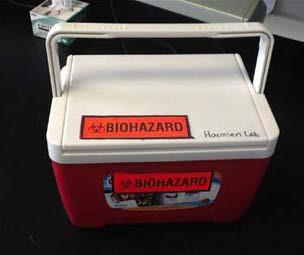Transporting Biological Agents
Updated 03/2024
Biosafety Officer: Amy Robison, amanda.robison@montana.edu (406) 994-6733
MSU Office of Research Compliance
This document describes the policy and procedures for transporting biological agents between MSU laboratories and buildings, as well as transporting biological agents from off-campus locations. Accidents can result in the release of these agents and potentially cause serious harm to people, community, and environment. It is the intention of this policy to provide a set of procedures to minimize risks of exposure during transport.
Researchers should consider the degree of risk associated with biological agents. Risk Group 1/ Biosafety Containment level 1 (RG1/BSL1) agents pose a minimal potential threat to people and the environment, while Risk Group 2/ Biosafety Containment level 2 (RG2/BSL2) agents are associated with human diseases, pose a moderate health hazard, and must be handled accordingly. For agent classification, refer to your IBC protocol or MSU Pathogen Safety Data Sheets.
Like other university personnel, researchers must adhere to all Montana State policies regarding transportation - (see Safety and Risk Management Auto Insurance Program for details).
Responsibility
Laboratory personnel that are transporting any biological agents must comply with the procedures in this policy. It is the responsibility of the Principal Investigator to ensure that 1). all laboratory personnel read and understand this policy and 2). all laboratory personnel have readily available access to the policy itself, as well as the materials required to properly and safely transport biological agents.
Transporting Biological Agents between Labs in the Same Building
- Biological agents must be placed in a labeled (names of biological agent, researcher, date), closed, leak- proof, shatter-proof primary container, preferably with a screw-cap lid (e.g. conical tubes, specimen cups). In the absence of a screw-cap, use parafilm to seal the container top.
- Primary container(s) must be placed in a secondary tray (e.g. autoclave bin), and then transportedon a lab cart.
- Spray primary container(s) with appropriate disinfectant. (e.g. 70% ethanol for 20-minute exposure time).
- Take special care when moving through public spaces; PPE is placed on the cart and not worn.

Transporting Biological Agents between Buildings or off-campus locations
- Biological agents must be placed in a labeled (names of biological agent, researcher, date), closed, leak-proof, shatter-proof primary container, preferably with a screw-cap lid (e.g. conical tubes, specimen cups). In the absence of a screw-cap, use parafilm to tightly seal the top of the container to minimize the potential for spillage.
- The primary container(s) must be placed in a labeled, leak-proof, shatter-proof secondary container that is sturdy enough to remain closed if dropped (see Fig. 2).
- Disinfect the secondary container with appropriate disinfectant (e.g. 70% Ethanol for 20-minute exposure time).
- Take special care when moving through public spaces, and do not wear PPE, including gloves.

Fig. 2. Labeled, sealed, shatter-proof container for transporting agents between buildings.
Updated/Approved by MSU IBC on 3-20-2024
